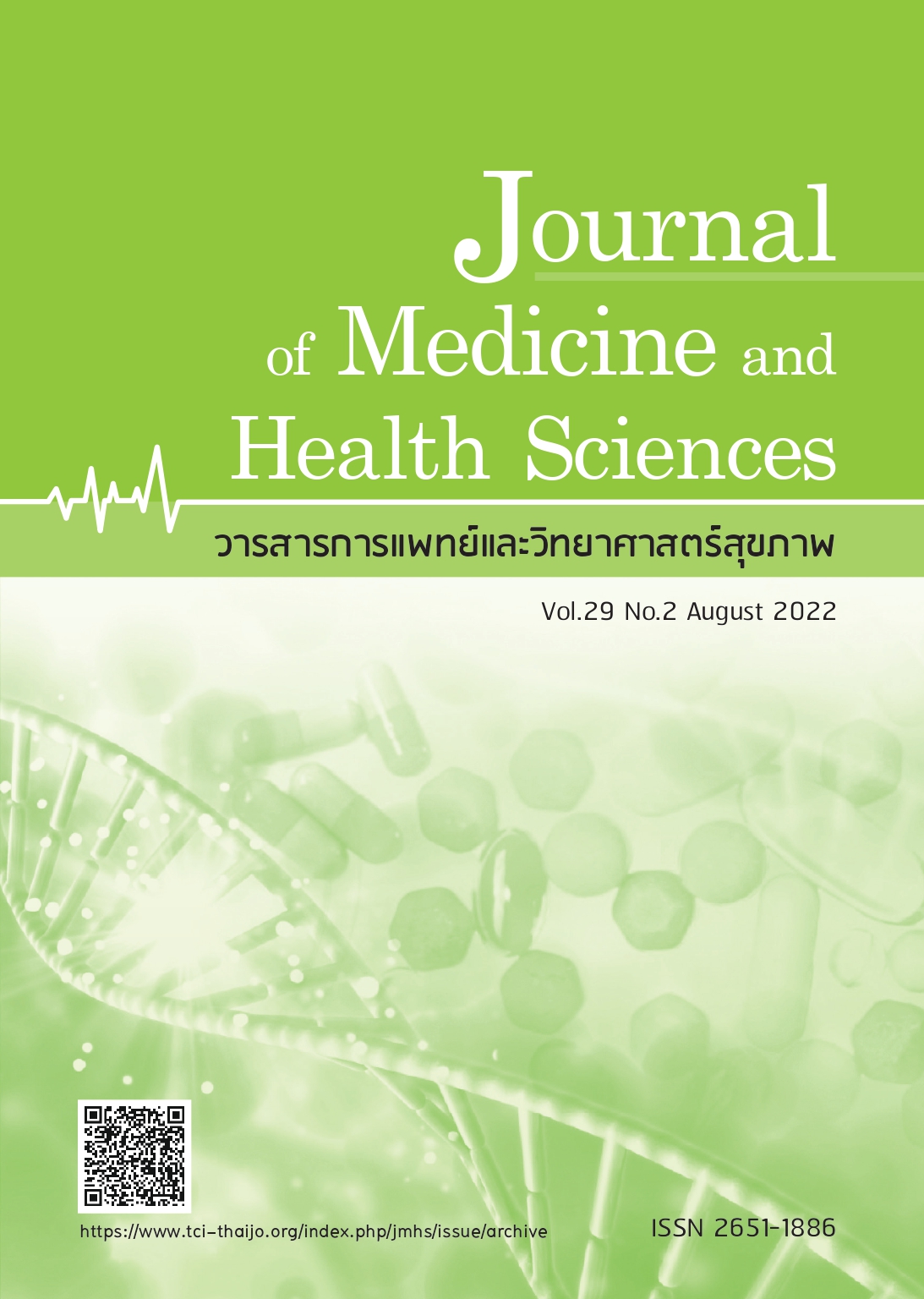The outcomes of using nursing care processes to prevent acute kidney injury from critically traumatic patients in shock
Keywords:
clinical nursing practice guidelines, trauma shock patients, acute kidney injuryAbstract
Abstract
The purposes of this study are to study the results of clinical nursing practice guidelines for the prevention of acute renal injury in accident patients with shock. The study was divided into three phases, as follows: The preparatory phase is a step to study the problem of acute renal injury. The development phase is a process for developing clinical nursing practice guidelines based on the ‘National Council on Medical and Public Health Research Council’s Developmental Guidelines Framework for Clinical Practice of Australia, 1999’ and the evaluation phase was divided into two steps: (1) to evaluate the effectiveness of the practice guidelines that have been tried on 20 critical accident patients; (2) to evaluate the results at for implementing established guidelines in three parts as follows: (1) the outcomes of the competency of nurses using the guideline to formulate an accurate and comprehensive nursing diagnosis; (2) the results of using the risk assessment form for acute renal injury; (3) a comparison of the incidence of acute renal injury, before and after, with no control group. The samples consisted of critical accident patients admitted to ICU from July to December 2019. The results revealed that there were 78 cases of critically injured patients. The incidence rate of acute renal injury was 26.9%. The results of assessing the credibility of the guidelines using the clinical evaluation model (AGREE instrument, 2001) consisted of the following: clarity of the guideline implementation objectives ( = 2.40, SD 0.52), contributors to the development of guidelines ( = 2.70, SD 0.47), clarity in presentation ( = 2.40, SD 0.52) and the application of department guidelines ( = 2.60, SD 0.52). All of the categories passed the criteria of 60%. The evaluation process in terms of effectiveness was assessed with regard to the satisfaction of 20 nurses using the guidelines had a high level of satisfaction (55.0%). The problems and obstacles in applying the guidelines, there were many opinions about the content, followed by a lack of understanding of some of the contents of the guidelines. When compared to the difficulty and ability to implement the guidelines, all of the assessment categories could be implemented in practice and the accuracy and coverage increased in all categories. Moreover, comparing the incidence of acute renal injury before and after using the guidelines showed a decrease from 17.4% to 16.0%.
References
Lozano R, Naghavi M, Foreman K, et al. Global and regional mortality from 235 causes of death for 20 age groups in 1990 and 2010: A systematic analysis for the Global Burden of Disease Study 2010. Lancet 2012;380:2095-128.
Murray CJ, Vos T, Lozano R, et al. Disability-adjusted life years (DALYs) for 291 diseases and injuries in 21 regions, 1990-2010: A systematic analysis for the Global Burden of Disease Study 2010. Lancet 2012;380:2197-223.
Haines RW, Fowler AJ, Kirwan CJ, et al. The incidence and associations of acute kidney injury in trauma patients admitted to critical care: A systematic review and meta-analysis. J Trauma Acute Care Surg 2019;86:141-7.
Susantitaphong P, Cruz DN, Cerda J, et al. World incidence of AKI: A meta – analysis. Clin J Am Soc Nephrol 2013;8:1482-93.
Gallagher M, Cass A, Bellomo R, et al. Long – term survival and dialysis dependency following acute kidney injury in intensive care: extended follow – up of a randomized controlled trial. PLoS Med 2014;11:1-13.
Laohatanakom S. Effectiveness of implementing clinical practice guidelines for prevention of delirium among critically patients, Medical intensive care unit Lampang hospital [dissertation Master of Nursing Science Adult Nursing]. Chiang Mai: Chiang Mai University; 2014.
Ngeonkaew P. Development of clinical practice guidelines for hyperthermia management in patients with traumatic brain injury, Chiangrai Prachanukroh hospital [dissertation Master of Nursing Science Adult Nursing] Chiang Mai: Chiang Mai University; 2013.
Yodying T. Effectiveness of Implementing nursing management guidelines among the elderly with Hypertension, Phrae hospital. Master of Nursing Science (Gerontological Nursing). Chiang Mai. Faculty of Nursing, Chiang Mai University: 2013.
Sae-Sia W, Songwathana P, Ingkavanich P.The development of clinical nursing practice guideline for initial assessment in multiple injury patients admitted to trauma ward. Aust Emerg Nurs J 2010;2:93-9.
Tanadkar N, Methakanjanasak N. Evidence based practice for acute kidney injury recognition and monitoring in critically ill patients. J Nurs Sci Health 2018;41:44-53. (in Thai)
Downloads
Published
How to Cite
Issue
Section
License

This work is licensed under a Creative Commons Attribution-NonCommercial-NoDerivatives 4.0 International License.



